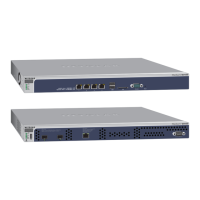Manage Stacking and Redundancy
282
ProSAFE Wireless Controller
After you configure the stack, you can change profiles, security settings, and WiFi settings on
the master controller, synchronize these changes with the slave controllers, and let the slave
controllers push the changes to the individual access points that they manage. For ease of
management, you can configure location-based profiles on the master controller and assign
a location to each slave controller.
Stacking allows WiFi clients to roam from an access point that is managed by one of the
controllers in the stacking group to any access point managed by the other controllers in the
same stacking group.
The master and slave controllers in a stack support the following capacities:
• Master controller. You can perform the following tasks:
- Manage the slave controllers
- Perform RF planning for the slave controllers
- Configure the entire network, including access point discovery and license
reinforcement
- Monitor the entire network
• Slave controller. You can perform the following tasks:
- Configure the subnetwork
- Monitor the subnetwork
- Upgrade the firmware image on the slave controller only
- Perform access point discovery for the subnetwork
- Reinforce licenses for the subnetwork
Note: A single WC9500 wireless controller that does not function in a stack
can manage up to 300 access point; a single WC9500 wireless
controller in a stack can manage up to 200 access points.
If a WC9500 wireless controller does not function in a stack and
manages more than 200 access points and you add the WC9500
wireless controller to a stack, all access points are removed from its
managed list. The access points are removed because of the
reduction in maximum capacity from 300 to 200 access points.
You must let the WC9500 wireless controllers in the stack rediscover
the access points and add them to the managed lists of several
WC9500 wireless controllers in the stack.

